Each year for the past decade or so, Rocky Mountain Shipwrights has presented an exhibit of model ships built by our members. The 40-plus models in this document record those from our 2015 October exhibit.
The winner of the “Best in Show” for 2015 was Ed Quam’s “Confederacy”, pictured below.
Best of Show – Ed Quam’s – Confederacy

Yacht America
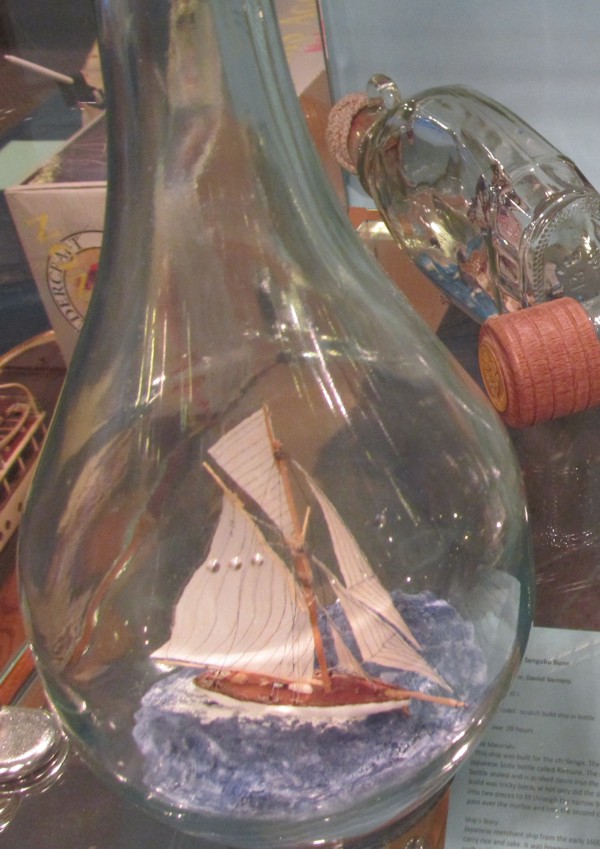
Modeler’s Name: Daniel Siemens
Type of Model: scratch build ship in bottle
Build Time: 20 hrs.
Build Materials:
Basswood, toothpicks and cloth
Ship’s Story:
The first winner of the “One Hundred Guinea Cup” later known as the America’s Cup named after the ship. The America sailed by Richard Brown won the cup by 18 minutes. After seeing America sail by, Queen Victoria asked who was second. She was answered, “There is no second, your Majesty.”
Modeler’s Bio:
I do accounting as my day job but love bottling ships when I can find time. I started two years ago after watching the fourth Pirates of the Caribbean movie
Venetian Galleass

Modeler’s Name: Mark Persichetti
Period: 1530-1600
Scale: 1:150
Type of Model: plastic kit highly modified
Build Time: not estimated
Build Materials:
This model is built from a kit produced by the Imai Company of Japan about 40 years ago. That kit, while depicting a unique old sail- and oar-driven wooden warship, is made up of molded-plastic parts. All the smooth-plastic surfaces were sanded with coarse-grit paper, to give them a wood-grain appearance. Sails are vacuum-formed thin plastic, sanded in two directions to give them a woven-fabric appearance.
Ship’s Story:
The Galleass type was an expansion of the typical Mediterranean rowed galley, which were long and narrow, propelled by oars in poor wind conditions, and by triangular-shaped ‘lateen’ sails in good winds.
Galleys typically featured battering-ram extensions at their bow, just above the waterline. At the Battle of Lepanto in October 1571, the combined Christian fleets under command of Don Juan of Austria fought against the Turkish fleet commanded by Muezzenade Ali Pasha. The loss of men on both sides was almost equal, but Turkish ship losses were close to 17-to-1 compared to the Christian fleets.
Modeler’s Bio:
Mark has been making models since the 1950s. His first sailing-ship model was a smaller-scale Old Ironsides kit by Revell. Ships have been his favorite modeling subject since then. He has been a member of Rocky Mountain Shipwrights for over ten years.
USN Picket Boat #1
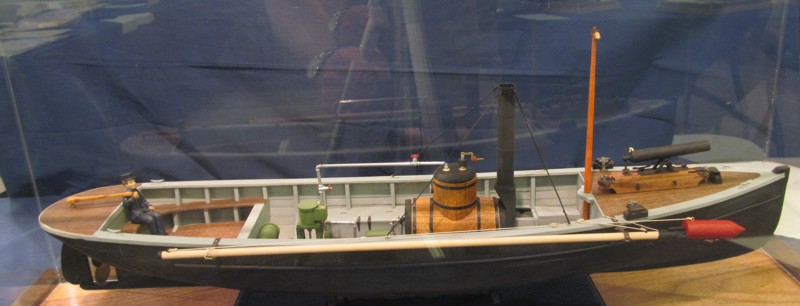
Modeler’s Name: Edward Quam
Period: 1864
Scale: ½” = 1’
Type of Model: plank on frame kit
Build Time: 6 months
Build Materials:
Basswood, Brass, Cast Britania Metal and simulated coal
Ship’s Story:
The boat was commanded by Lt Cushing and crew of 15. Cushing was a washout at the Naval Academy but was given this command because of his brash bravery. The mission was to sink the CSS Albemarle that was protecting the Albemarle Sound pinning down the Union forces. Cushing rammed the Iron Clad, placing the torpedo through a gun port and firing his 12 pound howitzer into it. Cushing was the only one to escape and made it to the Union forces. Declared a hero he was promoted to Lt Commander. The carved figure at the tiller depicts Cushing in full dress uniform.
Modeler’s Bio:
Edward is a retired former Intelligence officer. Born and raised in Colorado educated at CU, DU and Harvard. While stationed in Washington D.C. he was and is a member of the Washington Ship Model Association and a Plank member of the Nautical Research Guild. He has built over 25 models over 60 years of modeling and has displayed them in various venues around the country.
Red Dragon Chinese Junk
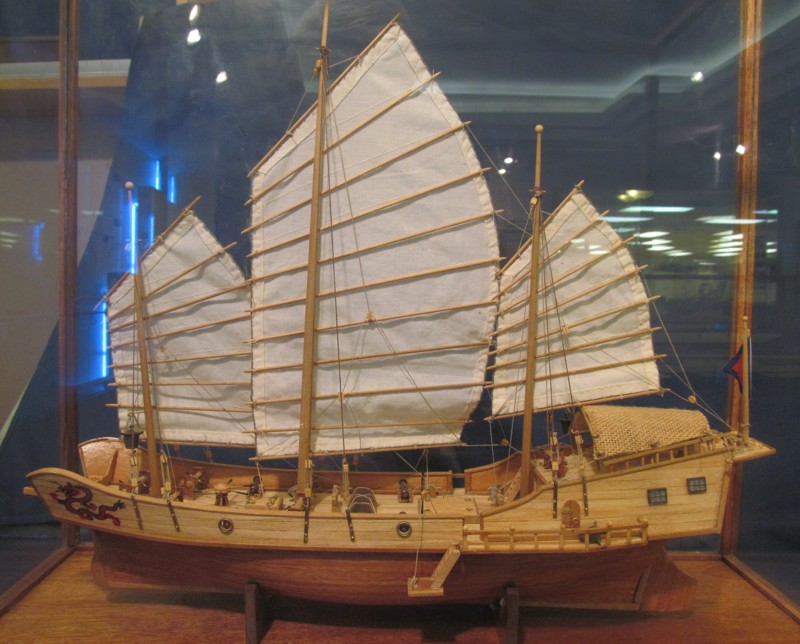
Modeler’s Name: Erik Collette
Period: last 300 years
Scale: 1:60
Type of Model: Modified kit
Build Time: 150 hrs.
Build Materials:
Boxwood, Sapelli, Walnut, Brass fittings
Ship’s Story:
The Red Dragon was a Chinese junk. These ships have sailed the Far East oceans as far as Africa for over 3000 years. They navigated with the help of the sun and over 2500 greater stars. Navigation became a lot easier when they invented the compass in the 11th Century. Originally, junks were built with a flat bottom and without a keel, a stem and stern posts. Only when they began to sail on the open ocean did it become a necessity to incorporate a keel to strengthen the ship. The junks were always built with watertight bulkheads which the Chinese learned from studying the structure of the bamboo plant. Junks are still built today, the same way as they were built centuries ago.
Modeler’s Bio:
Erik has been a member of the Rocky Mountain Shipwrights since he was bitten by the modeling bug after visiting the RMS show in 2003. He completed his first model in 2004. Erik hails from Norway, where he was around boats during most of his youth. He attended the Norwegian Naval Academy and sailed on a merchant ship for a year. He came to the USA in 1962 and earned his BSCE and MBA degrees from the University of Denver. He is currently semi-retired as an engineering consultant.
Queen Anne’s Revenge

Modeler’s Name: Daniel Siemens
Period: Scale:
Type of Model: scratch build ship in bottle
Build Time: 40 hrs.
Build Materials:
: This ship is mostly made of paper. Wire from a cell phone charger as well as paint brush bristles were used for the masts and spars. Tissue paper was used for the sails.
Ship’s Story:
The flag ship of the famous pirate Blackbeard. The Queen Anne’s revenge started out as a slave ship until it was captured by Blackbeard. He used it for piracy from the Caribbean to Africa and later ran it aground off the coast of North Carolina where it was recently found. The ship is based on the research of Mark Wilde-Ramsing Ph.D who did a lot of research on the history of the ship. The model is represented about as close as historians can figure the real ship may have looked.
Modeler’s Bio:
I do accounting as my day job but love bottling ships when I can find time. I started two years ago after watching the fourth Pirates of the Caribbean movie
Phantom Pilot Boat
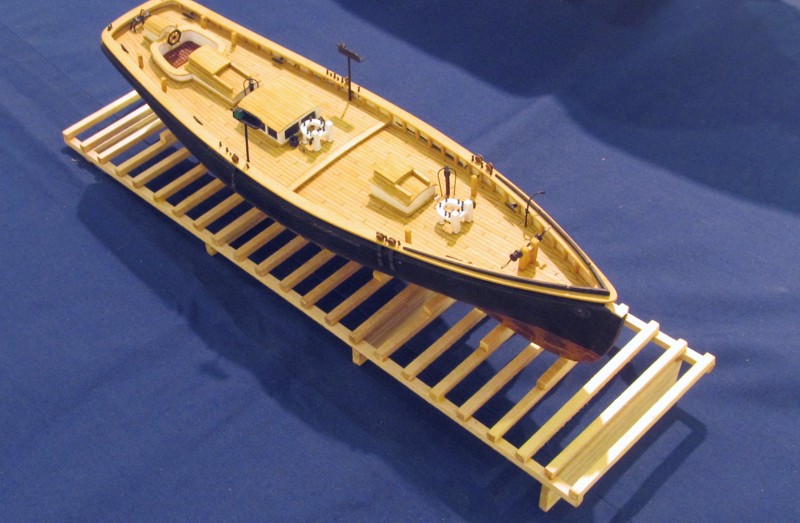
Modeler’s Name: Maxwell Fox
Period: 1868
Scale: 1:96 scale (1/8″ = 1 ft)
Type of Model: modified kit with solid hull
Build Time: 150 hrs
Build Materials:
The solid hull and copper plates are kit supplied. The deck was planked with boxwood strips, the deck houses and other fittings were scratch built using boxwood. The bowsprit, masts, and yards will be fabricated out of boxwood.
Ship’s Story:
Built in Boston, Massachusetts in 1868, the Pilot Boat “Phantom” was operated out of Sandy Hook as New York Pilot Boat No. 11. On March 14, 1886, Phantom was the first ship to offer support to, and rescued 852 passengers of the sinking British liner S. S. Oregon off the coast of Long Island. Two years later, she went ashore during the Great Blizzard of March, 1888 resulting in the total loss of the vessel and six crew members.
Modeler’s Bio:
I picked up wooden ship modeling during the transition from my time in the U.S. Air Force to my current status as a Mechanical Engineering student at Colorado State University. Additionally, I love to tinker and solve fabrication problems, so wooden model ship building and engineering were both natural fits for me. I am excited to participate in the Rocky Mountain Ship Wrights and look forward to learning all that I can from the experience of its members.
Oseberg Viking Ship

Modeler’s Name: Erik Collette
Period: 815 AD
Scale: 1:50
Type of Model: Kit built
Build Time: 150 hrs.
Build Materials:
Birch plywood, pine and basswood
Ship’s Story:
This ship was a Norwegian Viking ship built in approximately 815 AD. It was used as a burial ship in 834. It was discovered in a burial mound on the Oseberg Farm in Norway in 1904. It has been restored and can be seen today at the Viking ship museum in Oslo. It is 71 feet long with a beam of 15 feet. The construction was unique in that it was klinker built with iron nails and then the planks were tied to the ribs. The mast was approximately 35-40 feet tall. Homespun wool, woven into squares, was used for the sail. The squares were sewn together and the sail was reinforced with strips of leather. There were 15 oar holes on each side. The rudder was an enlarged oar fitted on the aft starboard side. In 2011, a full-scale copy was built to evaluate the design and test the ship’s seaworthiness. The ship is docked in Tonsberg.
Modeler’s Bio:
Erik has been a member of the Rocky Mountain Shipwrights since he was bitten by the modeling bug after visiting the RMS show in 2003. He completed his first model in 2004. Erik hails from Norway, where he was around boats during most of his youth. He attended the Norwegian Naval Academy and sailed on a merchant ship for a year. He came to the USA in 1962 and earned his BSCE and MBA degrees from the University of Denver. He is currently semi-retired.
Oliver Cromwell

Modeler’s Name: Terry Godwin
Period: Revolutionary War
Scale: ¼”=1”
Type of Model: Scratch build – plank on frame
Build Time: Six years
Build Materials:
Built using Harold Hahn plans and method of construction. The model is built in the Admiralty style. Completely scratch built. Woods used are boxwood, ebony, pear, holly, and apple. The model is approximately 85% complete. I have no intention of rigging the model.
Ship’s Story:
The Oliver Cromwell was a 24-gun privateer. She had previously been a merchant ship but in late 1776, at Philadelphia, was rechristened to help in the colonial cause. She carried a crew of 150 and may have had as her original name Juno. The Oliver Cromwell’s short, but lucrative privateering career only lasted 3 months. She was captured by HMS Beaver and rechristened Beaver’s Prize.
Navis Lusoria – Roman Troop Ship
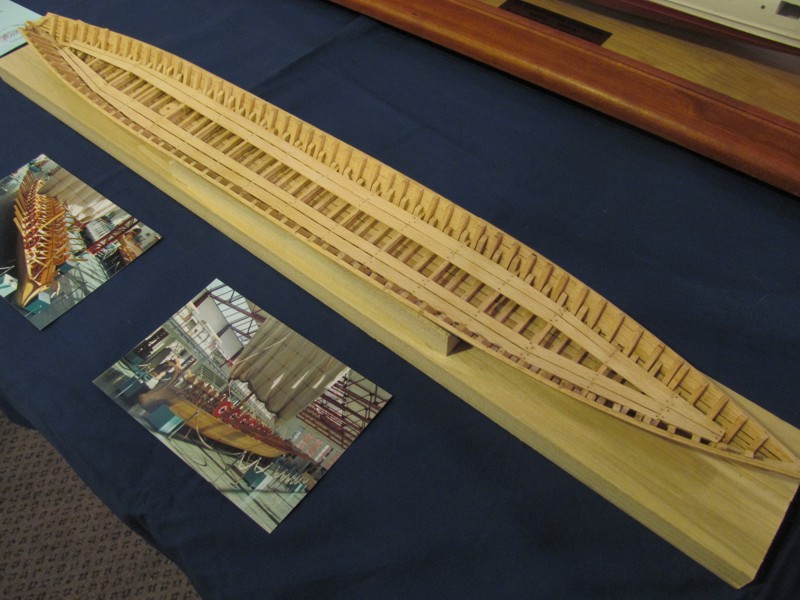
Modeler’s Name: John R. McGann
Period: circa 300 AD
Scale: 3/8”=1”
Type of Model: Scratch built
Build Time: 200 hours so far
Build Materials:
The Model is entirely scratch built and under construction using beech wood to replicate oak. The photograph is of a full sized reproduction of a “Navis Lusoria” displayed in the Mainz Museum
Ship’s Story:
The Navis Lusoria (Dancing Ship) was a riverine troop ship that was used by the Roman Legions to patrol the Northern Border of the Empire. The Rhine, Moselle, Main, and Danube marked this Northern Boundary. In 1981 during the excavation for an extension of the Hilton Hotel at Mainz, Germany the remains of five of the vessels were discovered. The wrecks have been salvaged and are displayed at The Museum of Antique Shipping, Mainz.
Modeler’s Bio:
Retired commercial construction general superintendent. First ship model completed 1944
Lizzie Metzner – Great Lakes Schooner
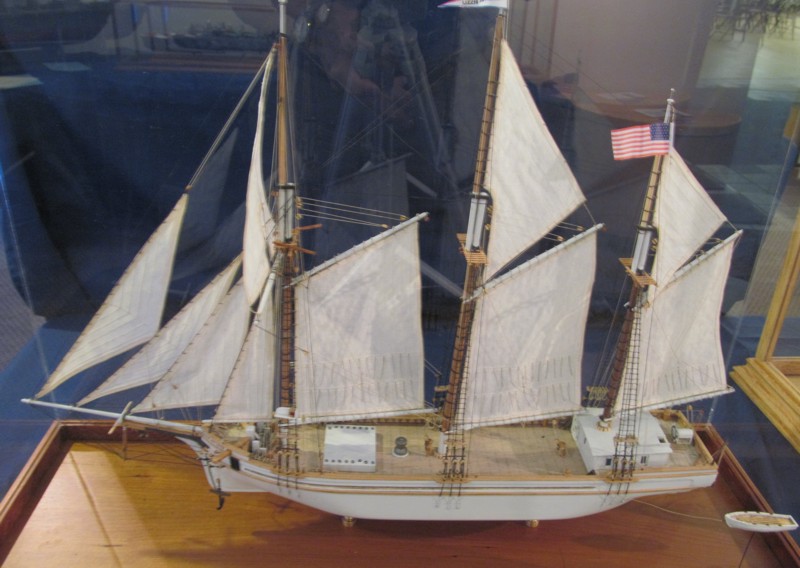
Modeler’s Name: Ralph Buckwalter
Period: 1888
Scale: 7/64 in. per ft.
Type of Model: scratch built solid hull
Build Time: not estimated
Build Materials:
No plans were available for this ship. Based on the plans for a similar ship which was 46 ft longer than the Lizzie I reduced the plans so the overall length was equivalent to the 81 ft of the Luzzie. I built the hull based on these plans modifying the hull based on the photos I had of the Lizzie. . The hull was done using the bread and butter method which consists of multiple thin lifts of wood cut to lines taken from the plans . I was intrigued by the triangular sail on the fore mast. I sewed all of the sails and bent them on as shown in the photos.
Ship’s Story:
The Lizzie Metzner was a typical Great Lakes Schooner which was used to carry various cargos on the great lakes. She was built in 1888 Rand and Burger in Manitowoc Wisc. for the firm of Mashek and Metzner of Kewaunee Wisc., who owned the south pier in Manitowoc. Wisc. The Lizzie Metzner was 81 ft. in length, had a beam of 21ft 8 in. and a depth of 6ft 9 in. Her gross tonnage was 77. She was built from blue oak and cost $1200 when delivered. The Lizzie Mitzner had a shallow draft,less than 3 ft.,and had a centerboard that could be used to take advantage of this shallow draft. She had a Raffee sail, a triangular top sail, on the foremast. These Raffee sails were the trademark of many Great Lake schooners.
Modeler’s Bio:
Ralph Buckwalter, a retired Mechanical Engineer has been modeling for about 14 years. He joined the Rocky Mountain Shipwrights in 2000. His first model was a pirate ship.
Le Hussard
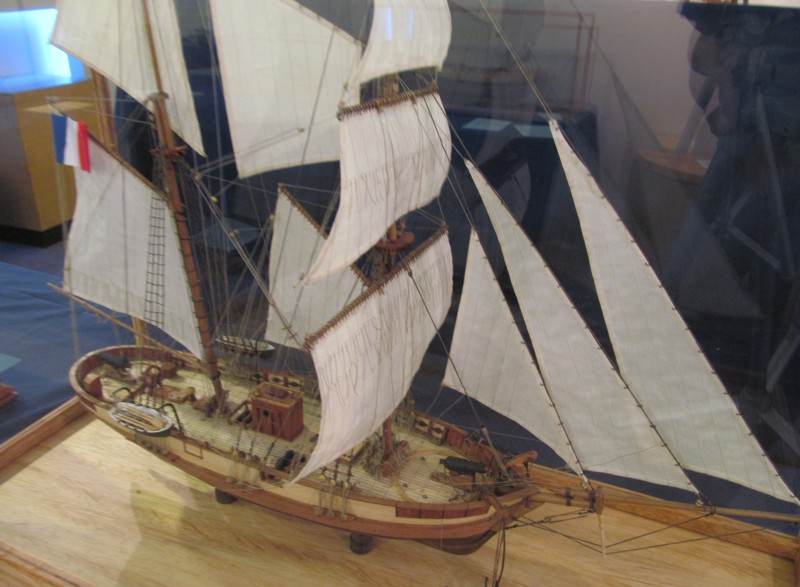
Modeler’s Name: Ralph Buckwalter
Period: 1845
Scale: ¼” = 1’
Type of Model: modified plank on bulkhead kit
Build Time: not estimated
Build Materials:
Build Materials: This model was built from an Artesania Latina kit that has been modified to more closely represent the description listed in the “Global Schooner”. I also used some information from “Souvenirs De Marine” by Admiral Paris which had better details than those of the kit. This included rigging and deck furniture. All sails were hand machine sewn and not the ones supplied with the kit. I also used a product named “Quicken” to stiffen and shape the sails.
Ship’s Story:
Le Hussard is identified as a French Brigantine built in 1845 in the kit, although she is described in the “Global Schooner” by Karl Heinz as a French Schooner. She was larger than her American and British counterparts. She has the following measurements: L – 98’ 6”, W – 27’ 11”, Depth in hold 9’ 2”. Her main feature was her armament. She carried two rotating carronades, 18 pounders, one in the bow and one in the stern. These rotating carronades were supposed to make Le Hussard a foe to fear but I don’t think this was the case. The bow panels would drop down so the carronade could be aimed at vessels low in the water close to the ship.
Modeler’s Bio:
Ralph Buckwalter, a retired Mechanical Engineer has been modeling for about 14 years. He joined the Rocky Mountain Shipwrights in 2000. His first model was a pirate ship, Black Falcon
KDM Dannebrog – Danish Royal yacht

Modeler’s name: Jim Cuscaden
Period: 1930’s onward
Type of model:Plank on frame kit
Scale: 1:100
Build materials:
The model was purchased in kit form in Norway in 1979 from Sergal Modelli. It was completed in 1980, but was damaged in a house move and restored in 2015. The model was built using a plank on frame construction using walnut, pine and metal materials.
Ship’s story:
The Dannebrog is named after the Danish flag and provides accommodation for the Queen and Prince Consort on royal trips. Since commissioning in 1932, the vessel has traveled more than 300,000 nautical miles. It is manned by 9 officers and 43 enlisted men.Laid Down : 1931; Launched : 1932; Commissioned: May 1932; Status: In service today. Displacement: 1238 tons; Length: 78 m; Height: 32m
Modeler’s bio:
Jim hales from England and was a member of the British Royal Navy. He has been a Shipwright member for about a year now, and is currently building the HMS Vctory.
